Lesson 2: Creating a Web Report Using Wizard
In this lesson, we will create a web report using the Web Report Wizard, that is using the standard way of Web Report Studio. The report will contain a table, a crosstab, and a chart.
This lesson contains the following tasks:
- Task 1: Create a Web Report Using the Wizard
- Task 2: Operate on the Crosstab
- Task 3: Perform on the Chart
- Task 4: Work with the Table
- Task 5: Apply a Filter
Task 1: Create a Web Report Using the Wizard
- On the Logi JReport Server Start Page, select Profile in the Manage category.
- In the Profile > Customize Server Preferences > General tab, select the Yes checkbox for Use Wizard for Web Report Studio. Select OK to save the setting.
Then in the prompt message box, select OK.
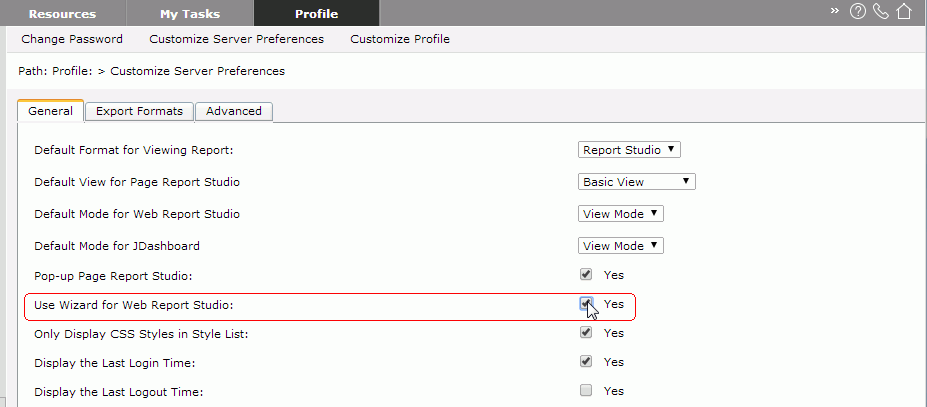
- Select Resources on the system toolbar to switch to the page, then go to the Public Reports > SampleReports folder.
- Select New > Web Report on the task bar.

The Web Report Wizard appears. In the Page screen of the wizard, select Template2, which allows for company logo, company name, and report titles to be defined and added in the report's page header panel. We will keep the current company logo and titles, and just change the report titles. In the Report Title text field, input Sales Performance. Leave the Sub Title text field blank. Then select Next.
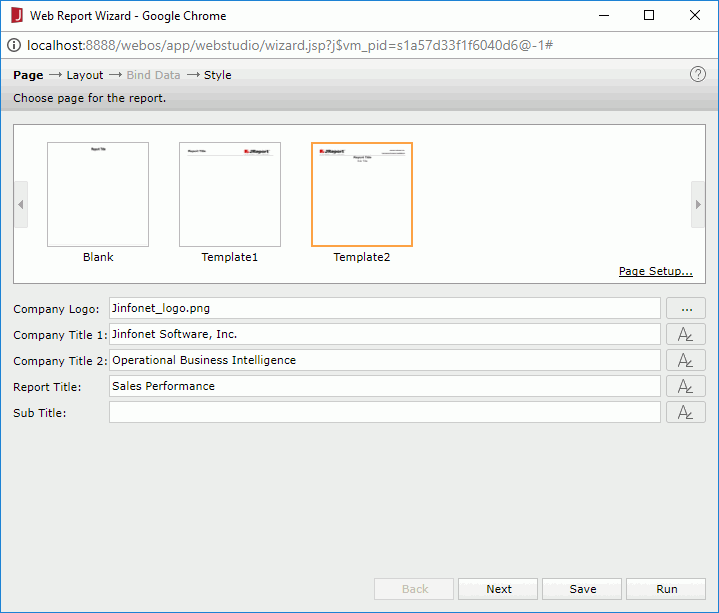
- In the Layout screen, select the T-Style layout. In the first tabular row, select the Click here to select component link in the left cell, select Crosstab from the drop-down menu, select Chart for the right cell. For the bottom cell, select Table from the drop-down menu.

- Select Next to go to the Bind Data screen to define data for the three components one by one. We will make the three components use the same business view. From the Data Source drop-down list, select WorldWideSalesBV in Data Source 1.
- First define the crosstab. Add Region to the Columns box, Sales Month to the Rows box, and Total Sales to the Summaries box.
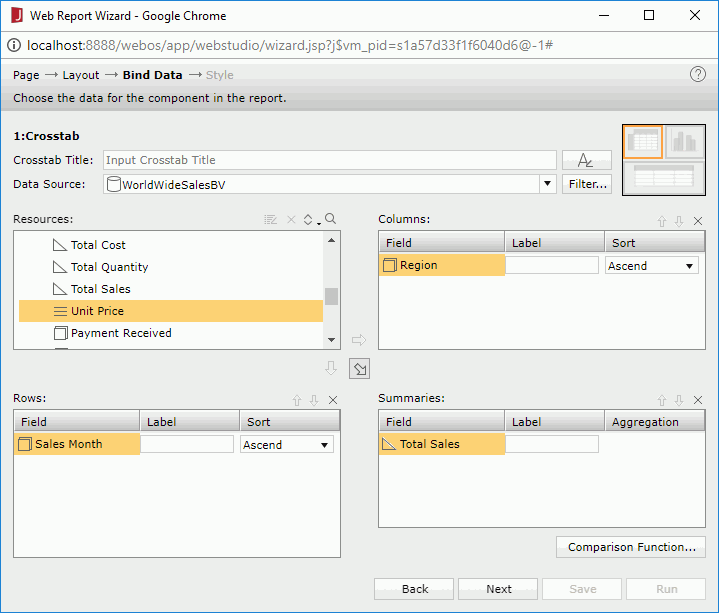
- Select Next to define the chart.
The default chart type is Clustered Bar 2-D, you can change it by selecting another type from the drop-down list.
Here we use the default type.
Add Total Sales to the Bar Length box and Country to the X-Axis box.
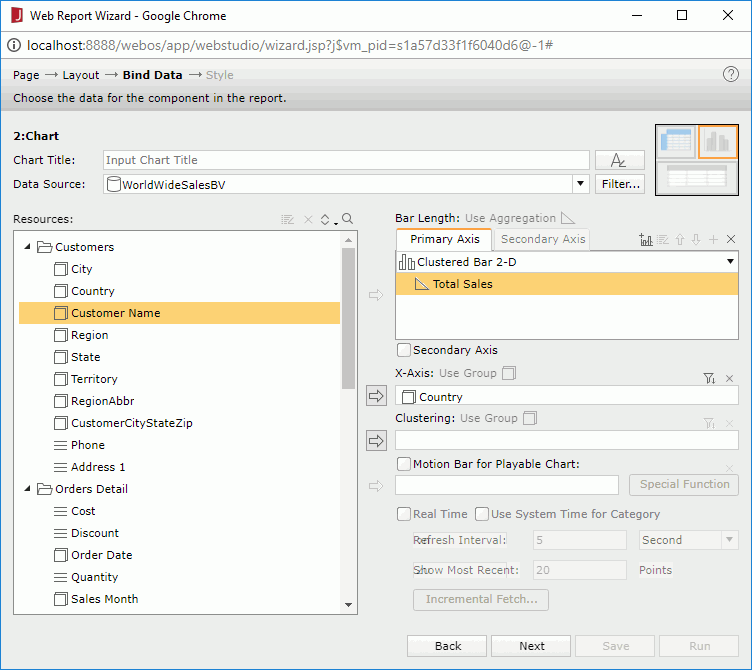
- Select Next to define the table. In the Details tab, add these fields: Customer Name, Product Name, Order Date, and Total. In the Group tab, add Country as the group by field.
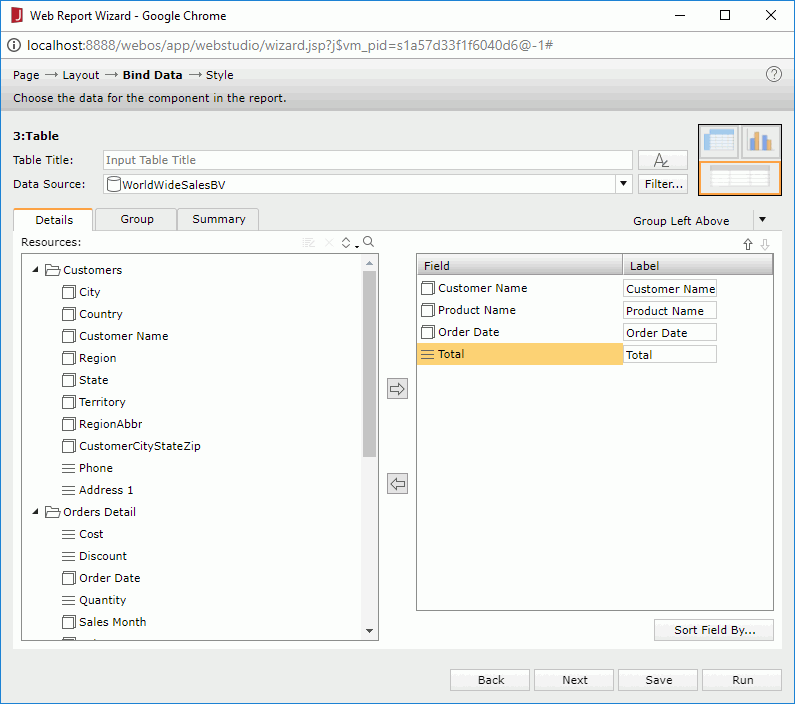
- Select Next to display the Style screen and select Neutral as the style.
- Select Run and the report is opened in Web Report Studio.
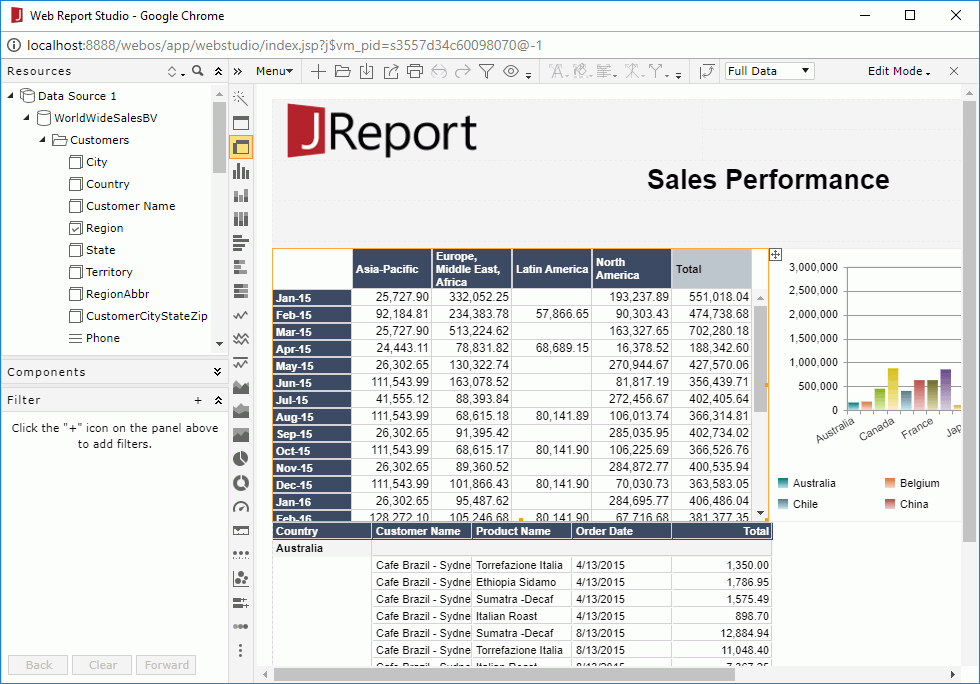
- Select the Save button
 on the toolbar.
on the toolbar. - In the Save As dialog, type SalesPerformance.wls in the File Name text field, then select OK to save the web report. In the prompt message box, select OK.
Task 2: Operate on the Crosstab
- First we want to change the style of the crosstab. Place the cursor in the crosstab, when the icon
 appears at its upper top left, right-click the icon, then select Apply Style > JReportDemo from the shortcut menu.
appears at its upper top left, right-click the icon, then select Apply Style > JReportDemo from the shortcut menu.
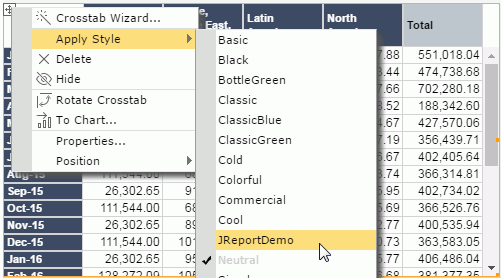
- We will change the data view from Sales Month to Sales Quarter in the row headers. Right-click the row header which displays months, select Switch Row > Sales Quarter from the shortcut menu. The row header now displays quarters.
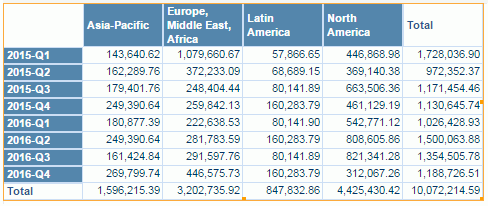
- To further view information about the product category in the first quarter of 2015, right-click 2015-Q1 in the row header, select Go to by Value > Category from the shortcut menu. The crosstab now shows the total sales of the product categories in the first quarter of 2015 in different regions.
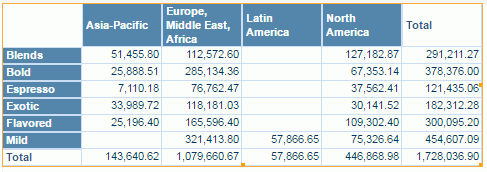
- The row and column headers can be switched. Select the Rotate Crosstab button
 on the toolbar.
on the toolbar.
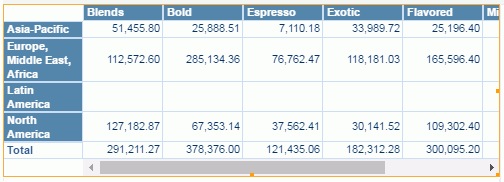
- Select
 on the toolbar to undo the rotation.
on the toolbar to undo the rotation.
A crosstab can be converted to a chart and vice versa. Next we want to convert the crosstab to a chart to view and analyze data from different aspects with different focuses.
- Place the cursor in the crosstab, when the icon
 appears at its upper top left, right-click the icon, then select To Chart from the shortcut menu.
appears at its upper top left, right-click the icon, then select To Chart from the shortcut menu. - In the To Chart dialog, the data fields used in the crosstab are listed. We need to define our chart based on these fields. Clustered Bar 2-D is the default chart type. Add the data fields as follows:
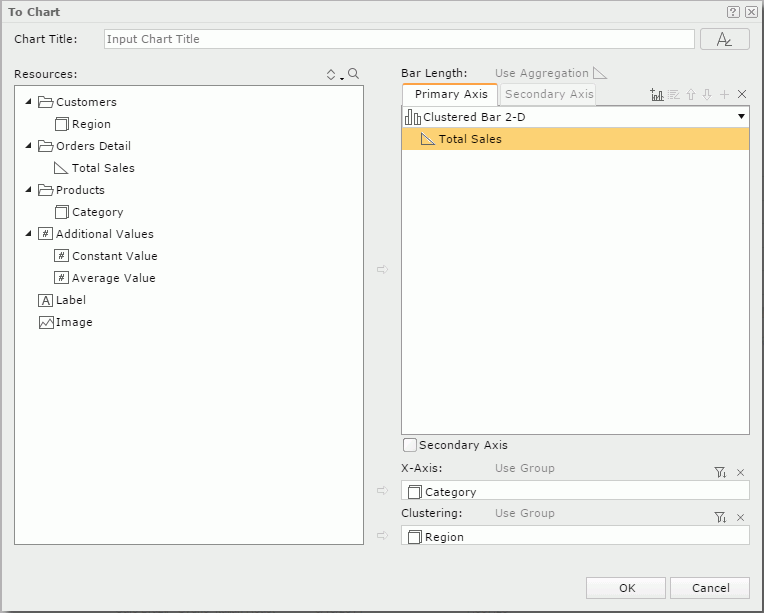
- Select OK. Here is the chart:
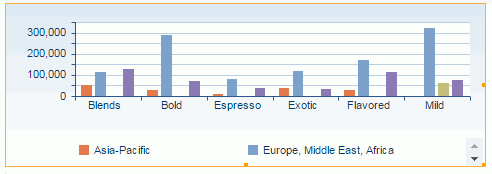
- To switch the category and the series values, select the Swap Chart Groups button
 on the toolbar. Resize the chart and it displays as follows:
on the toolbar. Resize the chart and it displays as follows:
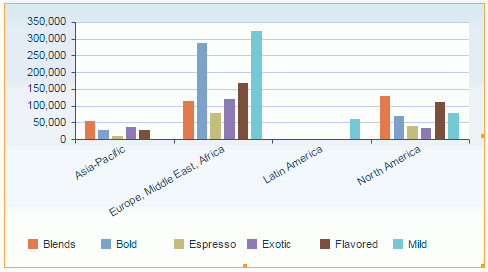
- Select
 on the toolbar to save the report.
on the toolbar to save the report.
Task 3: Perform on the Chart
- Point to any bar in the chart and a tip shows up. From the tip we can easily get the data information each bar stands for.
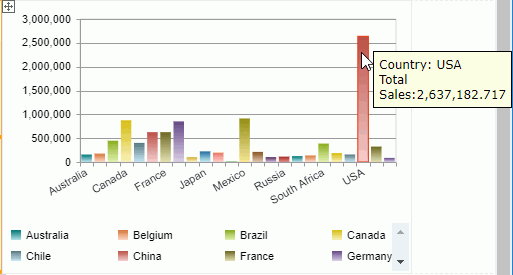
We want to link the chart values to a table which contains detailed information about the values.
- Right-click on a bar, select Edit Detail Table from the shortcut menu.
- In the Edit Detail Table dialog, add these fields to the right panel concerning the total sales in the countries: Country, Product Name, Quantity, Unit Price, Discount, and Total, then select OK.
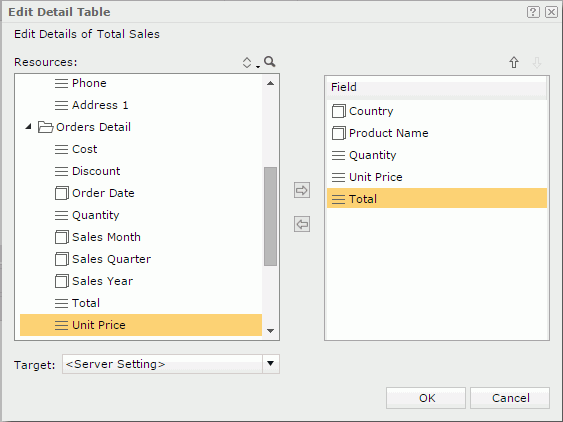
Now we can view the details about the chart values.
- Right-click on the highest bar which represents USA and select Go to Detail on the shortcut menu. The following table is displayed showing information about USA.
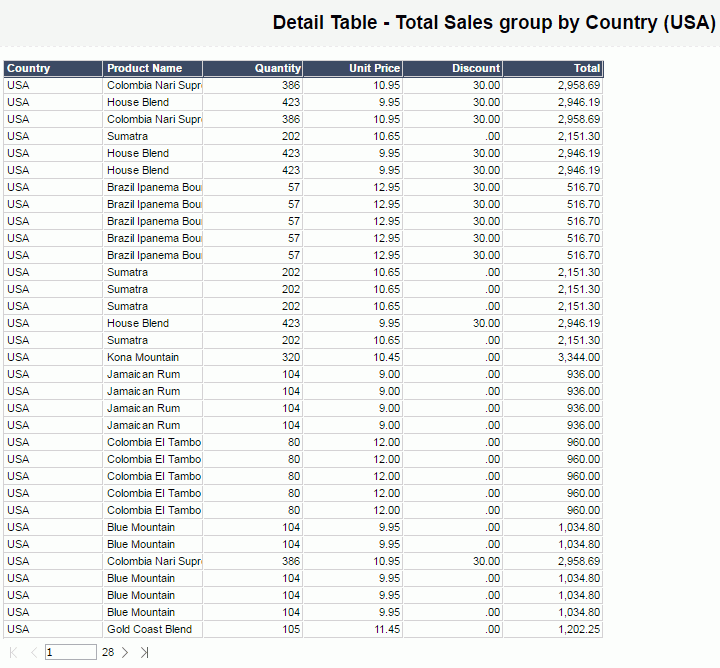
- Select
 on the toolbar to return to the main report.
on the toolbar to return to the main report.
Since the business view has a defined hierarchy, we can go through data upward and downward directly.
- Right-click any country name on the X axis and select Go Up > Region. The chart now displays as follows:
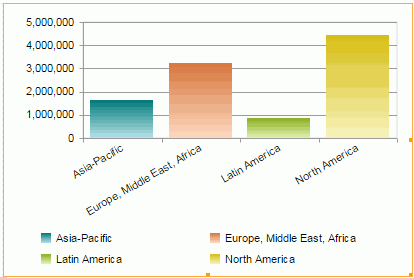
Next we want to go down from Region to Country, however it is not a reversed process of going up from Country to Region, but applying an additional filter.
- Right-click Asia-Pacific on the X axis and select Go Down > Country.
The chart shows the countries in the Asia-Pacific instead of all the countries.
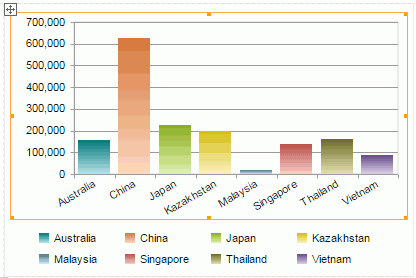
- Select
 on the toolbar to save the report.
on the toolbar to save the report.
Task 4: Work with the Table
- We first sort the table based on the Total column in descending order. Right-click any value in the Total column and then select Sort > Descend from the shortcut menu.
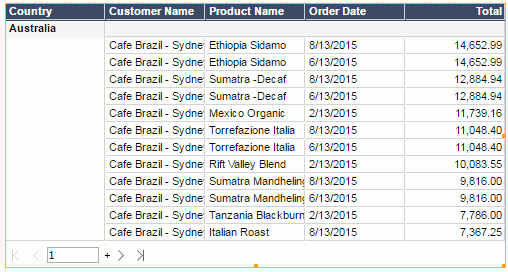
Next, we want to summarize the total sales for each country group.
- Right-click any value in the Total column, then select Aggregate On from the shortcut menu.
- In the Aggregate On dialog, set the function to Sum, then select OK. We can see the total sales for each country group is added in the group header.
The sum of total for Australia:
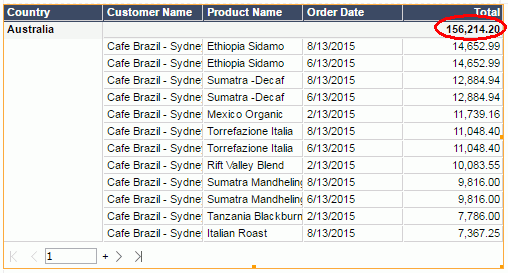
This operation also creates a dynamic aggregation which is given a default name Sum_Total. You can find it in the Dynamic Resource > Aggregations list in the Resources panel and you can use it again in the report.
Now we want to make the table linked with another report.
- Right-click on any Product Name value and select Link from the shortcut menu.
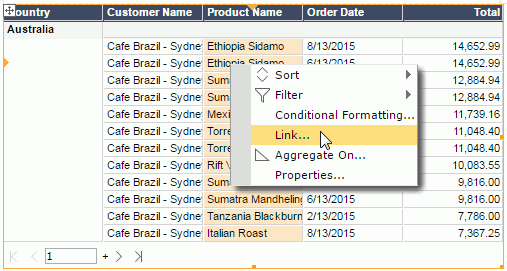
- In the Insert Link dialog, select Browse to select Link.wls in the SampleReports folder. Select OK.

- Select the More button to show more settings.
- In the Filter tab, select
 above the Components box. In the Choose Component dialog, select Bar Chart in the linked report as the link target and select OK.
above the Components box. In the Choose Component dialog, select Bar Chart in the linked report as the link target and select OK.
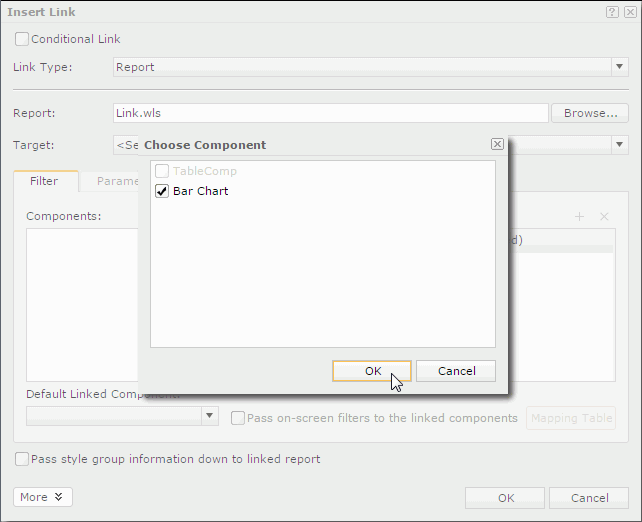
- Repeat the above step to add TableComp to the Components box.
- Select Bar Chart in the Components box, select the button
 above the Field Conditions box to add a condition row, then select the Product Name field from the Fields (Primary) and Fields (Linked) drop-down lists to set up the filter condition between the table and the target chart based on the field.
above the Field Conditions box to add a condition row, then select the Product Name field from the Fields (Primary) and Fields (Linked) drop-down lists to set up the filter condition between the table and the target chart based on the field.

- Select TableComp in the Components box, check Pass on-screen filters to the linked components and select OK to apply the settings.
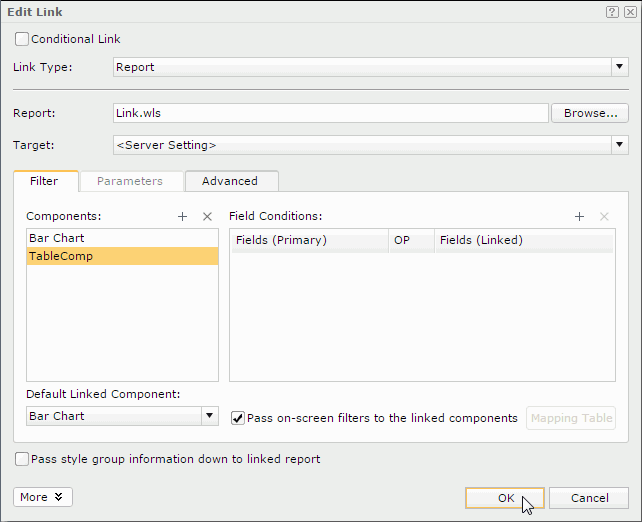
- Select View Mode from the mode drop-down menu on the toolbar.
- Select Mexico Organic in the Product Name column of the table, or right-click Mexico Organic and select Show Linked Target from its shortcut menu. The link.wls report is displayed with the chart filtered to show only data about Mexico Organic.
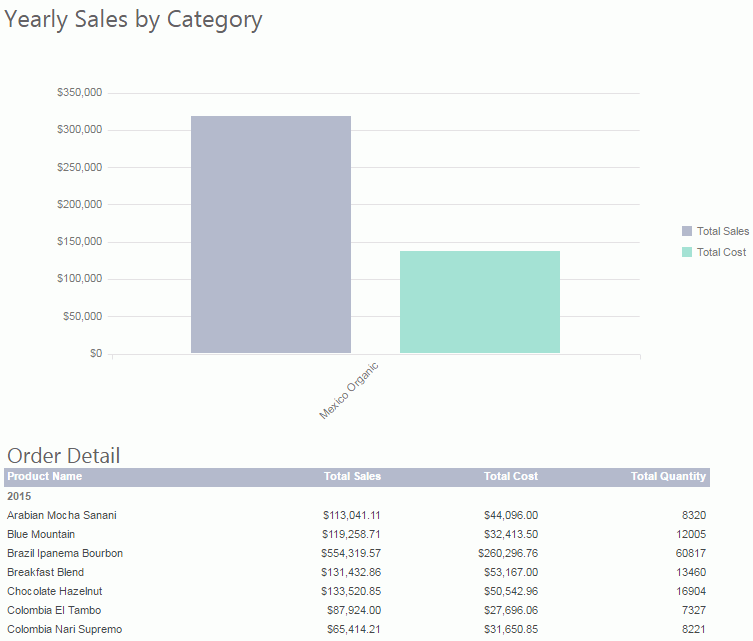
The following is the original link.wls for comparison:
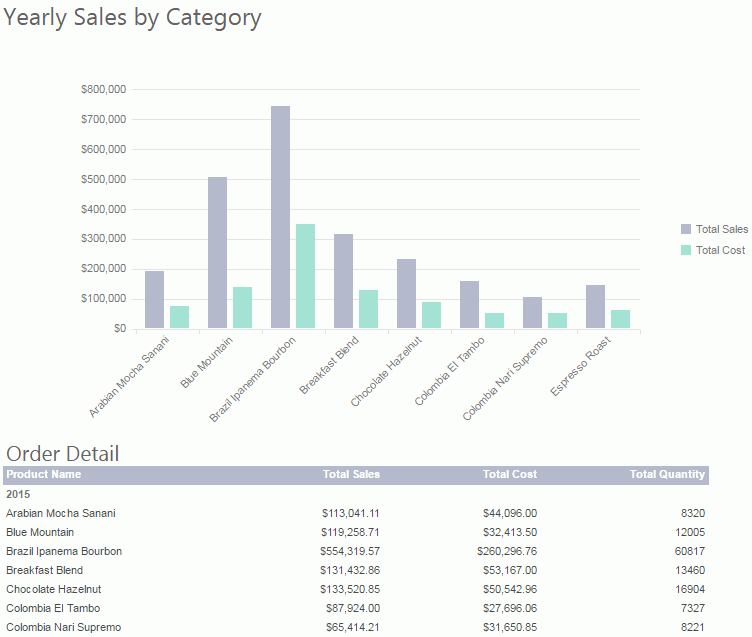
- Select
 on the toolbar to return to the primary report.
on the toolbar to return to the primary report. - Select
 on the toolbar to save the report.
on the toolbar to save the report.
Task 5: Apply a Filter
The three data components in the report use the same business view, therefore we can apply filters to them at the same time. Even if they used different business views, as long as they had the same field values from different business views you can still filter all components with a single filter. We can use the Filter panel and filter controls to filter report data and the filters created via the two are referred to as on-screen filters. For the usage of filter controls, you can learn from Creating Web Reports in the Advanced Part. Here we focus on using the Filter panel to dynamically filter report data. When we define the linked report in Task 4, we have enabled the on-screen filters to be passed from primary report to the table component in the linked report, so the filter condition specified via the Filter panel in the primary report will be applied in the linked report when we trigger the link.
We would like to filter data with product names, so we need to add the Product Name field to the Filter panel.
- Switch Web Report Studio to Edit Mode.
- Select + on the title bar of the Filter panel on the left, then in the Select Field dialog, select Product Name and select OK. The Product Name field is now added in the Filter panel with its values.
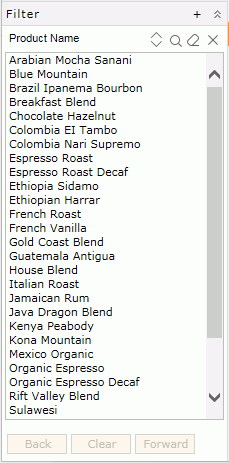
- Select Mexico Organic in the Product Name box. The report comes out as follows:

- Switch to View Mode. Select Mexico Organic in the Product Name column of the table to open the linked report.
This time the table in the linked report is also filtered to show only data about Mexico Organic as the on-screen filter defined in the Filter panel of the primary report is passed to it.
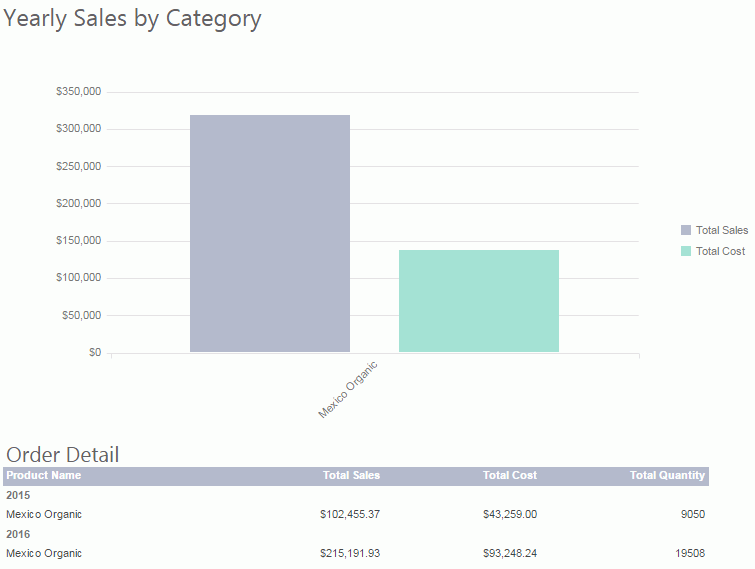
- Select
 on the toolbar to return to the primary report.
on the toolbar to return to the primary report. - Select
 on the toolbar to save the report.
on the toolbar to save the report.
 Previous Page
Previous Page